This is the story of my four day trip on Port Phillip Bay near
Melbourne, Victoria, Australia in mid April 2009. The trip started
from Footscray Melbourne at 5.30pm on Monday. I went upriver 20
minutes and tied up next to a pontoon, in order to gain experience
in sleeping with the boat. The next day I motored to Williamstown
and then to Port Arlington. On the Wednesday I had a very relaxing
day broad reaching in sunny skies to the Werribee river, where
I spent the night. The next day Thursday was a very difficult
trip going upwind and into a very steep vicious and fast moving
chop with a 2 to 3 ft swell with some larger waves. I got back
to Footscray at 5.45pm tired and weary but happy to be home.
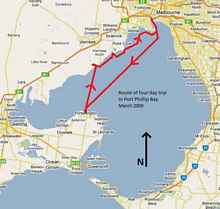 |
The Route |
Structural Failure
The boat suffered a structural failure with a 50cm crack between
the hull bottom and side. This was my fault. The heavy loads caused
by the pounding the boat endured were greater than the boat could
handle. The reason for this is as follows. The gusset at front
left of the hull was secured with only 1 screw, whereas other
gussets were secured with four screws. The glue area of the gusset
was insufficient.
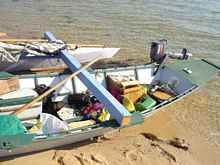 |
Note the 2hp Outboard |
When the boat was made, fibreglass went over the bottom and onto
the sides. Unfortunately I did not create a radius on the chine
before hand. Thus when I added the fibreglass I got a rough uneven
lay with wrinkles. Then in an act of silliness I smoothed the
chine to give a nice radius, in the process grinding back the
fibreglass, I did not subsequently apply fibreglass over the modified
joint. Thus there was no continuous fibreglass between the sides
and bottom. Fiberglas inside and outside the joint would have
been prudent.
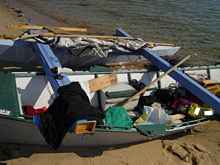 |
Lots of gear |
I have a dislike of stitch and glue. I know it can work well,
I have a personal preference for stringer frame. If I had a one
inch square chine log in the joint and secured with screws every
5 inches I feel it would have been much stronger. The crack can
be and will be repaired. The gusset will be replaced and secured
with several screws. I will grind back the paint and fibreglass
the joint. The trouble is that the number of changes required
may be adding good effort after bad. Perhaps it is best to deem
that my rowboat is suited to it's original purpose (rowing) and
is not optimised for as a rough weather multihull.
Notes on the Thursday Trip getting back home
This day started early with me waking up with the morning sun.
I spent a fairly good night sleeping in the boat, tied up to an
old post. The banks were muddy and steep and did not invite pulling
up there. It took a while to get organised getting setup to sleep
the night without being able to exit the boat. In the morning
I went to the wharf and spent a good forty minutes organising
my gear for the trip home.
The main thing to realise about this day was that to get home
I had to go NE and the wind was coming from the NE. Although fresh
in the morning it was not extreme, later it became awful. I started
by following the coast to Werribee South where I pulled onto the
beach and refueled and stretched my legs, spoke to a fellow who
said that as I was going out for four days it was obviously not
my first trip, I replied with a long ummmmmhhh.
Next things started to get a bit tricky. I passed with slight
headland at Werribee South. It was here that I went over a marked
shoal and lost my rudder. This was entirely my fault as the shoal
was marked on my chart but I was not reading it with care. The
loss of my rudder meant that I had to steer with the motor and
not with the rudder and fixed motor as I prefer. This was not
the disaster it may first appear as I could still steer with sails
and using my paddle as a steering oar. Thus I still had a contingency
if the motor failed.
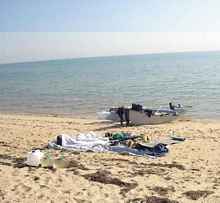 |
A shot of the boat and the beach |
I was angry with myself for not checking the synoptic chart to
determine from which direction the wind would be coming from on
that day. If I had looked at the chart, and made an estimate of
where the pressure systems would be in 3 days or so, I ought have
realised that winds would be from the North East on the day and
not from the South West as I had assumed. In Melbourne, the strong
winds usually come from the SW.
The next landmark of significance was Point Cook. On the west
side I was protected by the headland from the wind and the waves,
it was a bit breezy, but not too bad. After passing Point Cook
I new I would be exposed to the full force of the wind and waves.
I refueled again from the Jerry Can. I was always worried about
water from the funnel getting into the fuel and stopping the motor.
I have to say the Yamaha was faultless. Next I went for a walk
to the homestead to check it out and have a look at the bay further
on. I was able to spy a buoy a mile or so out, that marked a shoal
I had to stay clear of.
|
The Chart - needs laminating. |
I decided to go in a straight line from Point Cook to Williamstown,
in order to minimise the time spent in these conditions. It was
a bit tough. I realised that I was getting tired physically so
I made a point of warning thermals, a beanie, a polar fleece,
an oilskin, a jumper and a lifejacket. I was also careful to keep
up my fluids and energy levels, by drinking water and eating more
than normal as a contingency.
After passing Point Cook I wanted to keep well clear of the shoal,
this meant going out 2km from the beach. It also meant I was exposed
to waves that had many kilometres to gain height. In these conditions
the boat was pounding very heavily, going boom, boom, boom every
few seconds. The spray was bad coming back at me, even though
the boat is 18ft long. I eventually passed the marker but the
waves were slowing my speed, and I was not keen to refuel in the
middle of those conditions.
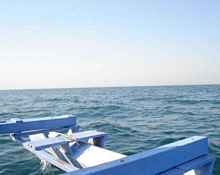 |
Under way |
At this stage I noticed the boat seemed to be getting a lot of
water. At this point I just assumed it was heavy spray, though
I learned later I had a structural failure. I was bailing regularly,
and after a minute or so, the water would be under control and
I would forget about it for a while. The outrigger was performing
well, cutting through the waves, whilst the dory hull was going
over waves and pounding. The shape of the hull was badly suited
to those conditions. The waves were very steep, closely spaced,
moving quickly. The bow would hit a wave, go up a couple of feet
and then slam down. Because of the combination of my speed into
the waves, and the closely spaced fast moving waves, I was hitting
a wave every two seconds or so. It should be pointed out that
I did not have many options. I have no car to pick up the boat
from a different location, and I had a flight booked for early
the next day
Things started to get more difficult. I told myself that if I
could keep going I would get into the lee of Williamstown, where
the wind and waves would be less and where I could have a rest.
I kept of going through, thinking that it was more psychological
than physical, and thus I had to use logic and not emotions. If
I could go one km, I could make 10. About 1km after passing the
shoal I got hit by a big wave. It was steep sided, pyramidal shape
and about 4ft high. I did not see it coming and it hit me partially
side-on. Just before it hit I realised that this was going to
be bad. It was way over the gunnel and moving fast. It decided
to pour it's contents into the boat just like that. In 2 seconds
I had a good 6 or 8 inches of water in the boat from just one
wave. At this moment the motor decided to quit. Actually it was
me twisting the throttle off in a moment of not concentrating.
I decided to tackle the situation by handing one issue at a time.
I realised that if I was hit by another 2 waves like the one that
just hit me that the boat would be completely swamped and I was
in a bit of bother. I restarted the motor, it started first pull,
and started bailing. Fortunately, all of my gear was tied on with
small lines and I did have buoyancy compartments fore and aft.
The bailing went well and within a couple of minutes I had the
water under control.
I kept on going, telling myself this was my best course of action,
just put up with a degree of discomfort and later on, all will
be well. I could feel myself becoming fatigued. I knew there was
a small inlet between Seaholme and Williamstown, so I headed slightly
to the left in order to gain protection from that shore. I was
out in these conditions for a good hour and a half, possibly more.
Some of the waves hit the front crossbeam heavily causing spray
and slowing the boat. All the while the boat was pounding very
heavily and I was contrasting it very unfavourably to the small
12ft windrush catamaran that I used to have that just loved the
waves.
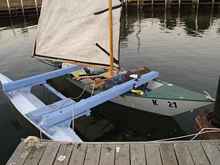 |
Fully rigged |
I was worried about running out of fuel and having to use the
jerry can in the middle of these conditions, and getting water
in the fuel tank, and having a dud motor. I think I refueled twice
on this leg, my memory is hazy though I do not know why. I have
recollections of refueling in the middle of the leg and not using
a funnel as I was worried about water. The funny thing was that
when the boat stopped, no water was coming into the boat and things
did not seem as bad. Eventually I got close to the lee shore and
was able to turn to the right and follow the coast near Williamstown
beach. Once I got close to the lee I knew I would be fine, I refueled
again and followed the coast around into the Yarra river and thence
home.
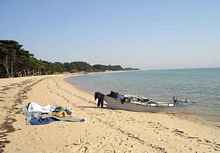 |
A great beach to land |
Realistically was I in danger? Answer, not greatly. I say this
because if the motor had stopped or the boat was swamped I would
have slowed down and traveled with the waves as opposed to going
against them. Thus the amount of water coming into the boat would
have been greatly reduced. I was only two or three kilometres
from shore, and I can swim that far if need be. The water was
fairly warm. I had flares, a mobile phone and a GPS. I would like
to get a handheld vhf radio. It the motor has stopped I could
have gone with the waves and current and used the steering oar
and my sail rig to make for Point Cook. It I was swamped, well
I would hope that I could bail out though if I was lower water
may get in more easily. I have bow and stern buoyancy compartments,
though these are not sealed with grease as recommended and would
keep water out for a limited period, but not indefinably. The
outrigger would float, as would the crossbeams, so there is the
option of the boat with the outrigger fine, but with the dory
very low and wallowing in the waves.
Plusses and Minuses of my boat
* The dory hull pounded very badly in the conditions on the
Thursday. It is true that many boats would experience problems
in those conditions, but the dory preformed badly going at speed
into a steep, closely spaced chop. A hullform with a stem much
closer to the vertical and a V bottom forward would be preferable.
The stern performed well, giving low drag at varying levels of
trim and providing security from following waves.
* More storage would be preferred. If the bow and stern compartments
were larger, that would assist with the storage issue and buoyancy
reserve in case of being swamped.
* The crossbeams which were overbuilt performed well.
* The outrigger shape was very good. I am getting some water
into the outrigger from the top of the supports. This was due
to poor construction and can be rectified, the outrigger is made
of 10 compartments so water in a single compartment is not a massive
issue. A lighter outrigger would be easier to man-handle, extra
weight could be added in terms of removable water containers.
* The flexible water bladders in the bow were essential for
trim, however they are not robust enough for rough conditions.
A built in ballast tank near the bow would be preferable.
* My bushwalking experience came in useful. The use of thermal
underwear, wearing a beanie, having a compass around my neck at
all times, the ability to take a bearing and follow a bearing
were all good things.
* The habit of storing all my clothes and bedding inside plastic
garbage bags was extremely prudent.
* Exposure is a real issue. Proper clothes and an oilskin for
protection from the elements is essential. The ability to keep
up energy levels via use of fluids and food can allow a situation
to remain challenging without going into the extreme or high risk
category.
* The cheap anchor without a chain was just about useless.
* I had a GPS, but do not know at the moment how to enter a
waypoint from via the map. Entering a dozen or 2 coordinates from
some reference material would be a good idea.
* The rig is easy to use. However it is about 30 percent smaller
than the ideal and it's upwind performance is debatable. A better
cut sail will no doubt point higher but not as high as a Bermudan
rig.
* The fixed rudder was a real pain, accessing a beach with the
fixed rudder is a real hassle. A kick-up rudder would have been
far superior.
* Having two good bailers (tied to boat) was a very good idea.
* Buoyancy compartments were a good thing to have. If I had
some foam inside them as well it would be better still. The small
hatches meant that only the smallest of items could be stored
inside the end compartments.
* I was very happy with both the outboard bracket and the outboard
well, the well needs to be 3 or 4cm higher.
* A realisation that things not built properly in the beginning
will have consequences later.
* I did not like to use the motor, but it got me out of a lot
of trouble.
* A need to be realistic with the number of kilometres traveled
each day. For example in the morning there may not be a breeze,
and then it gets dark a little after 6pm.
* A couple of good quality waterproof torches is essential.
* Carrying a small homebuilt cheap paddle proved to be a very
wise and smart move. It proved very useful and got me out of trouble.
It also provides an emergency steering mechanism should the rudder
fail.
* It is wise to study the charts and treat them seriously.
* A realisation that Port Phillip Bay can be very trying an
nasty.
* Learning from first hand experience is far preferable to learning
from books.
* Being able to swim well cant hurt, a wetsuit would be nice
to have too.
* The numbers on the boat came off. I should have epoxied over
them, or failing that painted then on.
* The removable thwarts worked well, carrying a toolkit was
prudent, things like spanners and screwdriver, shackles and spare
line are always useful. It is very wise to keep a good knife on
your person at all times.
* Laminating your charts is essential
*****

|

